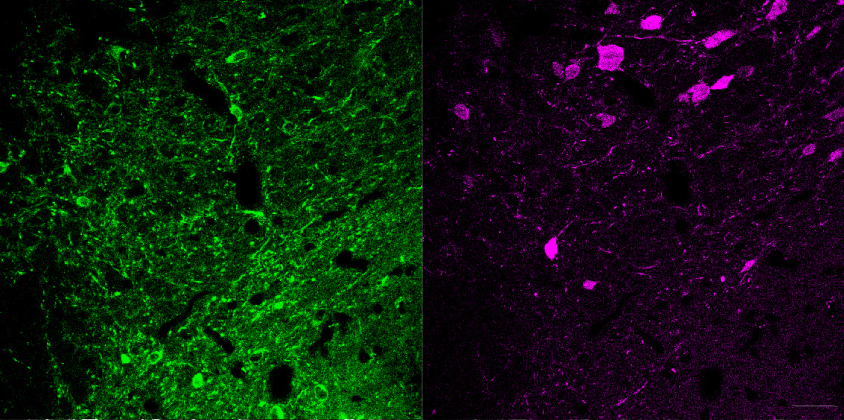
THIS ARTICLE IS MORE THAN FIVE YEARS OLD
This article is more than five years old. Autism research — and science in general — is constantly evolving, so older articles may contain information or theories that have been reevaluated since their original publication date.
Using a new device, researchers can eavesdrop on neural chatter between distant brain regions as mice socialize. The tool, described in this month’s Nature Methods, could reveal how neurons communicate during social exchanges between mice that carry autism-linked mutations. 1
The tool is the latest iteration of fiber photometry, in which an ultra-thin cable transmits light into the brains of genetically modified mice. The light excites fluorescent proteins, which glow when neurons fire. The same cable relays this glow to a camera, which captures bursts of light that represent firing neurons.
Researchers previously used fiber photometry to look at activity in part of the brain’s reward center, called the ventral tegmental area (VTA), as two mice interact. The new study takes the method a step further by splitting a single photometry cable into seven branches. These branches can track neuron-firing in distant regions, from the surface to deep inside the brain. The long, thin tether connecting the mice to the camera allows the animals to interact relatively unencumbered while researchers watch from afar.
Researchers tested the tool by implanting the cable’s branches into seven regions of the mouse brain, including the prefrontal cortex — a surface region involved in cognition — and two reward regions, the VTA and nucleus accumbens, in the brain’s interior. The camera revealed that neurons in these far-flung brain regions are more in sync when a mouse meets a ‘friend’ than when the mouse is alone.
Rewarding routes:
The new method is sensitive enough to detect firing in a neuron’s large cell body as well as in its thin axon, which projects to distant neurons. The researchers used this sensitivity to monitor activity in VTA neurons that express dopamine, a chemical messenger involved in reward. Reading from the main cell body shows that, as a group, these neurons fire more when mice get a treat and less when they feel a mild shock on their tail.
Looking at the far-reaching axons of these same neurons, the researchers found that those that connect to the nucleus accumbens also fire in response to reward. But dopamine neurons that connect to the amygdala — a brain region that processes emotion — react to both the shock and the treat. And when the neurons project from the VTA to the prefrontal cortex, they fire more in response to the tail shock than to the reward.
The researchers also optimized the new technique for other purposes. For example, they can use it to distinguish between two different types of neurons (labeled with different fluorescent molecules) in the same brain region.
The light transmitted through a photometry cable can also be used for optogenetics, in which light is used to activate specific sets of neurons. The new method allows researchers to fine-tune levels of stimulation in optogenetics experiments by kindling and reading activity simultaneously.
By joining the discussion, you agree to our privacy policy.